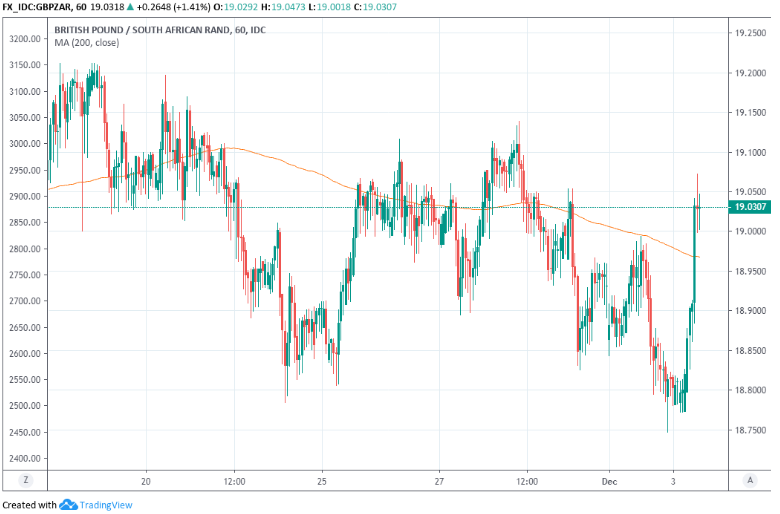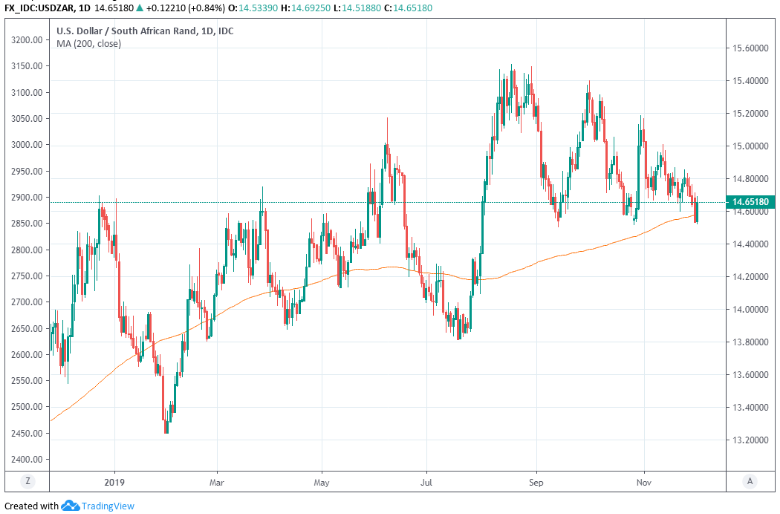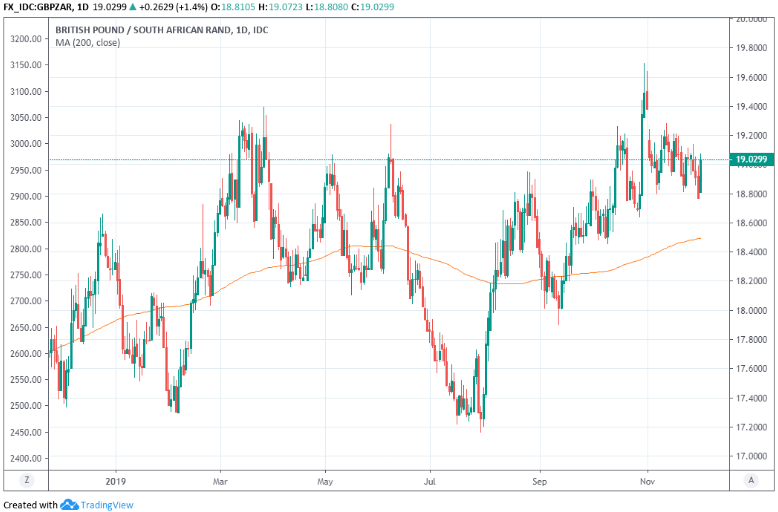South African Rand Hammered by Shock GDP Data and Fresh Trade Tensions
- Written by: James Skinner

Image © Adobe Images
- ZAR slumps after data reveals Q3 economic contraction.
- SA at risk of second recession in little more than a year.
- As Moody's watches...and waits for credible budget plans.
- And U.S.-China trade tensions flare again, threatening ZAR.
The Rand sank Tuesday after official data revealed a surprise contraction in the economy for the third-quarter, which landed on the newswires just as markets were again becoming uneasy about the outlook for the U.S.-China trade talks.
South Africa’s economy contracted by -0.6% in the third quarter, partially reversing the annualised 3.2% increase seen in the second quarter and coming in substantially below the 0.1% growth anticipated by the market for the period. The country is now at risk of seeing its second ‘technical recession’, which is defined as two consecutive quarters of contraction, in little more than a year.
"After opening at its strongest level since the beginning of October, the rand has traded on the back foot today after a poor GDP reading for Q3.," says Simon Harvey, an FX analyst at Monex Europe. "Today’s reading doesn’t bode well for an economy buckling under increasing debt levels and the sustainability of the current stock. The last thing the government needs after Moody’s changed the credit outlook to negative was a second economic contraction this year. The slump in economic activity will weigh on tax revenue and therefore the trajectory of debt-to-GDP, increasing the pressure on Moody’s."
The contraction was driven by declines in output from the mining, manufacturing and transport, storage and communication industries. Statistics South Africa says the biggest driver was a 3.9% annualised fall in output from the key manufacturing industry, which has struggled of late amid weak domestic demand and as the global manufacturing sector creaks under the stress of U.S. trade tariffs that have hurt China and Europe’s economies.
"Hardly good conditions for maintaining the country rating, as all three major rating agencies have given the country a negative rating outlook. Following a few rather easy days the rand is likely to come under pressure against this background," says Elisabeth Andreae, an analyst at Commerzbank.

Above: Pound-to-Rand rate shown at hourly intervals.
Currency markets care about the GDP data because it reflects rising and falling demand within the economy, which has a direct bearing on consumer price inflation, which is itself important for questions around interest rates. And interest rates themselves are a raison d'être for most moves in exchange rates.
Changes in interest rates are normally only made in response to movements in inflation, which is sensitive to growth, but impact currencies because of the push and pull influence they have over capital flows. Capital flows tend to move in the direction of the most advantageous or improving returns, with a threat of lower rates normally seeing investors driven out of and deterred away from a currency. Rising rates have the opposite effect.
Investors care about South Africa’s GDP data especially because it could be significant in determining whether the country can cling to its last remaining investment grade credit rating awarded by Moody’s.
Moody's wants to see credible plans from the government that give confidence in South Africa’s ability to reduce its budget deficit and stem a sharp rise in the debt-to-GDP ratio. Without such plans the country could see its credit rating cut to ‘junk’ as soon as February 2020, which would risk encouraging large outflows from South Africa and the Rand.

Above: USD/ZAR rate shown at daily intervals.
"Stability of supply and cost of electricity, along with the size of Eskom’s debt guaranteed by government continue to weigh on investor confidence in SA, along with NHI and EWC policy uncertainty and the growing risk of multiple credit rating downgrades. A Moody’s downgrade would see higher borrowing costs and rand weakness," says Annabel Bishop, chief economist at Investec.
The Rand slumped against the Dollar and Pound in response to the data because it was seen by investors as making a rating downgrade more likely. However, the South African currency’s losses could have been made worse by statements from President Donald Trump, who told the press in the morning session that he doesn’t have a deadline for sealing a ‘phase one deal’ with China and that it could be best to wait until after the 2020 election to finalise an agreement that was already said on October 11 to have been struck.
Hopes of a ‘phase one deal’ to end the trade war have been running high in recent weeks but progress toward achieving one has been thin on the ground. U.S. language around the pact has changed of late, with the White House now saying regularly only that such a deal is possible - rather than actually done. Those hopes however, had fueled a rebound in high-yielding emerging market currencies that looked to be coming undone on Tuesday.
"High hopes combined with low volatility tend to create a "buy first, ask questions later" mentality and this is certainly the dominant driver for now. Our basic approach in this environment has been to favour owning high-carry currencies relative to negative yielders in cases where the political risk premium is flat or falling and where the balance of payments position is stable or improving," says Shahab Jalinoos, head of FX strategy at Credit Suisse, in a recent note to clients. "Currencies such as TRY and RUB where the balance of payments picture is stable or improving and political risk is already largely priced are also preferable to the likes of ZAR and HUF where the outlook for fiscal and monetary policies respectively are not currency-supportive."

Above: Pound-to-Rand rate shown at daily intervals.
Fears over the outlook for the domestic economy and credit rating are increasingly seeing the Rand shunned by investors and strategists, many of whom say the South African currency could be left out in the cold during 2020 even if the rest of the emerging market universe does well. Morgan Stanley tipped the Rand last month for underperformance throughout 2020 while others like Credit Suisse are also sceptical of its prospects.
Analysts at MUFG recently profited from a recommendation to buy the USD/ZAR rate, which is a trade that they’ve since closed - although the bank has said it would look to buy the Dollar and sell the Rand again upon a pick-up in volatility. Such a pick-up might not be far off either, especially if the White House opts not to delay fresh tariffs that are set to be imposed on imports from China on December 15. President Donald Trump has this week demonstrated that he still has an appetite for tariffs even in spite of increasing evidence that his trade policies are also slowing the U.S. economy too.
"The chances of a deal by Dec 15th just took another turn lower. Markets simply aren’t priced for this; for a trade deal to be that far in the future – if one can even be struck at all," says Mark Wilson, chief market analyst at Markets.com. "After weeks of making generally positive noises on a deal being very close, there is a real sense now that a deal is not so very near at all and markets need to reprice. Combined with the barrage of tariff threats on the EU, the comments can be taken as a sign that the White House has no qualms about levying further tariffs and is happy about using trade as a economic, political and diplomatic weapon."
Time to move your money? The Global Reach Best Exchange Rate Guarantee offers you competitive rates and maximises your currency transfer. Global Reach can offer great rates, tailored transfers, and market insight to help you choose the best times for you to trade. Speaking to a currency specialist helps you to capitalise on positive market shifts and make the most of your money. Find out more here.
* Advertisement





